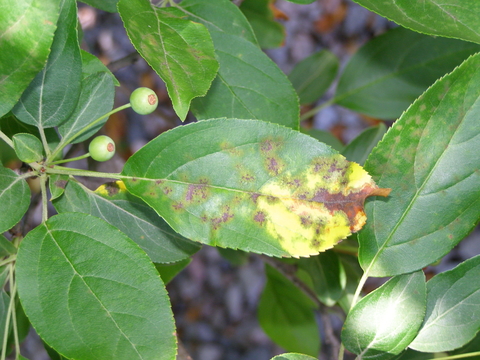Apple and scab are two words most people would never associate with each other, but apple scab is one of the most significant diseases that impact apples.
The disease is caused by a fungal pathogen known as Venturia inaequalis, which produces spores that remain dormant or “sleep” through the winter on apple leaves and fruit and then “wake up” when rain occurs in the spring. Once the original spores have been spread by rain splash or wind, they can start infecting leaves and fruits, producing more spores. With each rain event, spores continue to spread and cause more infections throughout the tree, and the cycle continues again and again.
Infected leaves start with light brown or olive-green spots that can eventually worsen, leading to yellowing leaves and, eventually, leaf drop.
When fruits become infected, at first, symptoms may look olive-green and eventually turn scabby or cork-like as fruits continue to grow and ripen.
Apple scab can infect both fresh-eating apples and crabapples. Some apple varieties are more susceptible to infections than others.
2024: A bad year for apple scab
This year’s frequent rain events made apple scab infections worse than usual in many Minnesota regions. At this point of the season, most of the damage has been done and many trees have lost a large portion of their leaves, which can stress trees over the winter.
What can you do to lessen next year’s apple scab infection?
- Remove or mow apple leaves. Infected apple leaves are the source of next year’s infection. After leaf fall, rake and remove apple leaves from the area, or mow them to make it easier for microbes to break the leaves down.
- Remove infected apples. Apple fruits are also a source of infection. Fruits with minor blemishes can be eaten or used to make apple sauce, and more severely infected fruits can be thrown away, or composted in an enclosed area.
- Prune to increase canopy airflow. Pruning helps to reduce the chance of infection because well-pruned trees should have more open canopies, which allows for more airflow. With more airflow comes faster drying of leaves and fruits, which makes it harder for the water-loving apple scab spores to cause an infection.
- Plant resistant varieties. When choosing an apple variety to grow, consider how resistant it is to apple scab. Talk with nursery staff or read the varietal descriptions on apple tree vendor websites. See our list of recommended varieties for Minnesota.
Because apple trees and crabapples grow abundantly in urban areas, spores might blow over from a neighboring area onto your trees, but these steps listed above can greatly improve your chance for less disease in 2025.
Finally, keep in mind that how much infection happens next year will also depend on the weather, as drier years will lead to less infection spread.
For more information about apple scab, visit our webpage, Apple scab of apples and crabapples.



